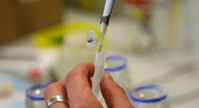Health
4 Paws strives to ensure that all our puppies will be happy, healthy, life long companions for you and your family no matter whether you are looking for a show, herding, agility or companion dog.
Health Testing is very Important to 4Paws and any dog that we breed. This page is dedicated to the health testing we do and why.
All our dogs will have a notation with their information, on what their results to these testings are.
All 4Paws dogs have been DNA tested for PRA/PRCD, HC, DM and MDR1 .
The results are generally listed as
Normal/Clear (this means the dog does not carry copies of the gene )
Carrier (this means that the dog carrys one copy of the gene and does not have the disease )
Affected (this means that the dog has 2 copies of the gene and will have the disease) We do not breed any dogs that are affected.
DNA genetic results listed as " Clear by parentage" Means both parents are clear, therefore no testing is required. The dog is clear because two clear dogs produce clear dogs. (This has been verified by testing.)
PRA -
prcd-PRA test is a DNA-based test that helps you avoid one form of Progressive Retinal Atrophy (PRA). PRA refers to a group of diseases that cause the retina of the eye to degenerate slowly over time. The result is declining vision and eventual blindness. “prcd” stands for “progressive rod-cone degeneration” which is the type of PRA known in several breeds.
PRA Disease
The genetic disorder, prcd-PRA , causes cells in the retina at the back of the eye to degenerate and die, even though the cells seem to develop normally early in life. The “rod” cells operate in low light levels and are the first to lose normal function. Night blindness results. Then the “cone” cells gradually lose their normal function in full light situations. Most affected dogs will eventually be blind. Typically, the clinical disease is recognized first in early adolescence or early adulthood. Since age at onset of disease varies among breeds, you should read specific information for your dog. Diagnosis of retinal disease can be difficult. Conditions that seem to be prcd-PRA might instead be another disease and might not be inherited. OptiGen’s genetic test assists in making the diagnosis. It’s important to remember that not all retinal disease is PRA and not all PRA is the prcd form of PRA. Annual eye exams by a veterinary ophthalmologist will build a history of eye health that will help to diagnose disease.
Unfortunately, at this time there is no treatment or cure for PRA. If your dog is affected, you may find it helpful to read about other owners’ experiences living with blind dogs. (suggested links:www.eyevet.org and www.blinddogs.com)
Inheritance
Prcd-PRA is inherited as a recessive trait. This means a disease gene must be inherited from each parent in order to cause disease in an offspring. Parents were either “carrier” or affected. A carrier has one disease gene and one normal gene, and is termed “heterozygous” for the disease. A normal dog has no disease gene and is termed “homozygous normal” – both copies of the gene are the same. And a dog with two disease genes is termed “homozygous affected” – both copies of the gene are abnormal.
It’s been proven that all breeds being tested for prcd-PRA have the same disease caused by the same mutated gene. This is so, even though the disease might develop at different ages or with differing severity from one breed to another.
Although prcd-PRA is inherited, it can be avoided in future generations by testing dogs before breeding. Identification of dogs that do not carry disease genes is the key. These "clear" dogs can be bred to any mate - even to a prcd-affected dog which may be a desirable breeding prospect for other reasons. The chance of producing affected pups from such breedings depends on the certainty of test results. Again, you’ll find the specific information on certainty of test results for your dog by linking to breed specific information.
The Genetic Test
The OptiGen prcd test is done on a small sample of blood from the dog. The test analyzes the specific DNA mutation causing prcd-PRA. The OptiGen test detects the mutant, abnormal gene copy and the normal gene copy. The result of the test is a genotype and allows separation of dogs into three groups: Normal/Clear (homozygous normal), Carrier (heterozygous) and Affected (homozygous mutant).
HC
Heredity Catarats Description
Cataracts are a clouding of lens of the eye caused by a breakdown of tissue in the eye. This generally results in an inability to see clearly, and can cause total blindness. In canines, cataracts are often familial; this type is known as Hereditary Cataracts. A mutation in the HSF4 gene causes this type of cataracts in several breeds of dogs. In this case, the dog is typically affected bilaterally, in that both eyes are affected by the cataracts. The cataracts associated with HSF4 also occur in the posterior region of the lens. They usually begin small and grow progressively, though the speed of growth is highly variable. Some cataracts will grow so slowly that the dog's vision remains relatively clear, while others will grow such that the dog will quickly go blind. Corrective surgery is possible, though it is costly and is not always effective.
One HSF4 mutation causes the recessive form of Hereditary Cataracts in Boston Terriers, Staffordshire Bull Terriers, and French Bulldogs. Because it is recessive, a dog must have two copies of this mutation to experience this form of cataracts. This mutation is only responsible for early-onset hereditary cataracts, which typically occur between 12 months and 3 years of age in Staffordshires, and between 2-3 years in Boston Terriers. Boston Terriers can also be afflicted by late-onset hereditary cataracts; however, the HSF4 gene mutation is not responsible for that particular form of cataracts. The causative gene for Late-onset Hereditary Cataracts in Boston Terriers has not been determined at this time.
A separate mutation of the HSF4 gene is responsible for Hereditary Cataracts in Australian Shepherds. This mutation affects Aussies differently, in that the disease is dominant, but not completely penetrant. This means that only one copy of the mutation is necessary to predispose a dog to the disease, however, incomplete penetrance means that a dog that has this mutation will not always develop HC. Research suggests that the mutation makes a dog 12 times more likely to develop posterior bilateral cataracts at some point in their lifetime. It is likely that a secondary gene interaction occurs in the small percentage of dogs possessing the HC mutation but do not develop cataracts, however, this interaction is not yet know.
It should also be noted that not all cataracts are hereditary. Cataracts can also be caused by old age or injury. Also, cataracts that occur in different regions of the lens can also be familial, however, are not attributed to this gene mutation.
The results are generally listed as
Normal/Clear (this means the dog does not carry copies of the gene )
Carrier (this means that the dog carrys one copy of the gene )
Affected (this means that the dog has 2 copies of the gene and could develop HC)
MDR1
MDR1 is the abbreviated name of a gene called Multi-Drug Resistance 1. A mutation of this gene causes sensitivity to Ivermectin and a number of other drugs. Dogs with the mutation will react to those drugs. Having two copies of the mutation will lead to drug reactions, but having a single copy can also confer some sensitivity with some drugs. Dogs with this mutation have a transport defect - the drug goes in to their brains, fails to be transported out, and builds up to toxic levels. This causes serious neurological problems including seizures and sometimes death.
Which drugs cause reactions?
Ivermectin was the first drug recognized to cause a reaction, but it is far from the only one. Ivermectin at low dosage, as found in heartworm medications, will not cause a reaction. The larger doses needed for worming will. Other commonly administered drugs on the list include acepromazine and Imodium. Fortunately, there are alternative medications available if your dog requires treatment.
The results are generally listed as
Normal/Normal or clear, (this means the dog does not carry the mutation, will not pass the mutation and should not react to any of the drugs listed at the link below)
Normal/Mutant or carrier (this means that the dog carrys the mutation, may pass the mutation and may react to the drugs listed at the link below)
Mutant/Mutant or affected (this means that the dog has 2 copies of the gene and will react to the drugs listed at the link below)
The drugs involved can be found on the website below.
OFA:
Is the Orthopedic Foundation for Animals that provides radiographic evaluation, data management, and genetic counseling for canine hip dysplasia. All our breeding dogs are xrayed by a certified vet and evaluated by OFA. OFA certification involves having a veterinarian take x-rays of the dogs hip joints. The x-ray is then sent to OFA for evaluation and the dog is given a "grade". OFA grades of Excellent, Good, and Fair are all considered normal, non-dysplastic grades. OFA certification can not be done until a dog is 2 years old, although a preliminary evaluation can be done prior to that for breeding purposes. All 4 Paws dogs are certified or have a preliminary evaluation prior to breeding..All dogs in our breeding program are rated good or better. One of our females that was planned to be a breeding female's OFA that showed slight dysplasia. She was pulled from our breeding program and spayed.
For more information on OFA click here.
CERF:
Is the Canine Eye Registration. It is a means to examine a dogs eyes to determine if it has an inheritable eye disease. Genetic eye problems are common in almost all breeds of dogs. A CERF test is performed by a certified veterinary opthalmologist. During the test, the vet looks for approximately 25 different heritable eye defects. A CERF rating of "Normal" means that no signs of any of the defects were found. We have all our breeding dogs examined by an American College of Veterinary Ophthalmologists (A.C.V.O. ) diplomat, for eye disease. One of our young males, was found with an eye disorder before breeding age and we pulled him from our breeding program. For more information about CERF click here .
DM:
Degenerative Myelopathy (DM) is a progressive neurological disorder that affects the spinal cord of dogs. Dogs that have inherited two defective copies will experience a breakdown of the cells responsible for sending and receiving signals from the brain, resulting in neurological symptoms.
The disease often begins with an unsteady gait, and the dog may wobble when they attempt to walk. As the disease progresses, the dog's hind legs will weaken and eventually the dog will be unable to walk at all. Degenerative Myelopathy moves up the body, so if the disease is allowed to progress, the dog will eventually be unable to hold his bladder and will lose normal function in its front legs. Fortunately, there is no direct pain associated with Degenerative Myelopathy.
The onset of Degenerative Myelopathy generally occurs later in life starting at an average age of about 8 years. However, some dogs may begin experiencing symptoms much earlier, some later, and a small percentage of dogs that have inherited two copies of the mutation will not experience symptoms at all. Thus, this disease is not completely penetrant, meaning that while a dog with the mutation is highly likely to develop Degenerative Myelopathy, the disease does not affect every dog that has the genotype.
Animal Genetics, Inc
4 Paws Miniature American Shepherds




